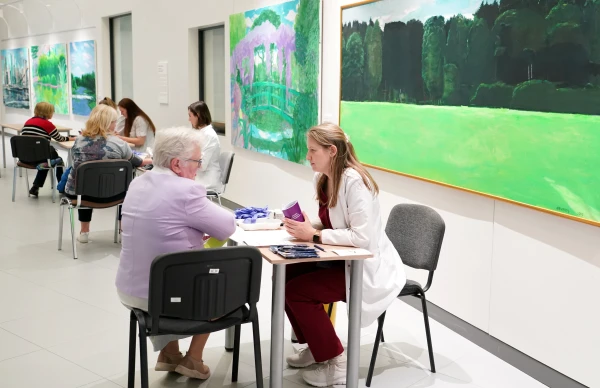
The autumn-winter season traditionally brings exacerbations of various diseases, and in the field of healthcare – anxiety: who and where will treat us?
Moreover, the three largest hospitals in Latvia – Gaiļezers, Stradiņš, and Children's Hospital – will be forced to operate under severe funding SHORTAGES in 2026. The money has been allocated in the name of defense!
In October, the situation with inpatient medical care was discussed at the Saeima Committee on Social and Labor Affairs. Politicians – just like us! – have a poor understanding of what is happening inside the huge hospital complexes and needed some basic education.
All the Best – Definitely for Children?
According to the report from the Children's Clinical University Hospital (BKUS), over 8 months in 2025, 10,186 people were treated there, with the highest number of discharges occurring in April – 1,381. This is understandable: by spring, young bodies weaken, and children more often end up in hospital beds. Naturally, it is better to provide necessary assistance in advance – and from January to August, outpatient medical care was provided at the Children's Hospital 249,788 times. The maximum, again, in April – 33,200 patients.
Unfortunately, it happens that children are brought to the hospital complex, built on Vienības gatve in the early 20th century by then-mayor of Riga George Armistead, by ambulance: there were 47,431 such cases in 8 months, with April leading again – 6,354 cases of emergency medical assistance.
The Children's Hospital accepts patients from almost all of Latvia: hospitals of levels I-III physically cannot perform even medium-level surgeries. Of course, there are IV-level hospitals in Daugavpils, Liepāja, and Valmiera, but often parents prefer to take their children to the capital for reliability.
This year, the maximum number of surgeries was performed in July – 732, and a total of 5,566 in 8 months. March had the highest number of day patients – 744.
Currently, the financial aspect of hospital affairs seems to prevail over the medical one. The year 2026 promises planned losses for BKUS, and not small ones: minus 5,615,228 euros.
The hospital's turnover is planned to increase by almost a million: prices for medicines and equipment, utilities, and staff salaries will rise. And it would be fine if they raised the "minimum wage" for orderlies and nurses, but it turned out that there are doctors in Latvia who earn as much as 40,000 euros a month.
Stradiņš: Facts and Figures
The largest hospital in the country, Stradiņš, has 840 inpatient beds with an average occupancy of 85%. And on these beds – 3,367 staff members. That is, more than 4 people serve an average patient?! When was the last time you were in a hospital, did you notice that?
However, at the Clinical University Hospital Stradiņš (PSKUS), the largest number of staff is service personnel – 1,268 people, followed by support staff – 1,160 people, then actual doctors – 871, and at the top of the "food chain" is administration – 99.
This year, Stradiņš Hospital:
- admitted 48,682 inpatient patients,
- provided 312,883 outpatient consultations,
- conducted 119,291 laboratory tests,
- ensured 61,429 ambulance calls,
- performed 60,890 surgical operations.
At the same time, considering the most complex cases, the average length of stay for a patient in bed is only 5 days!
The hospital's turnover in 2025 will exceed 200 million euros, which, for comparison, is more than the budget of the city of Daugavpils. Of this amount:
- 167 million euros – inpatient and outpatient care; (and against this background, paid medical services look quite modest – 6.8 million)
- about 6 million – scientific and educational activities;
- 109.9 million euros – staff salaries;
- 74.1 million – medicines and medical supplies;
- 3.9 million – equipment maintenance;
- 2.7 million – food (which means an average of 11 euros per patient per day).
And about the problems
Here are the problems that most concern Stradiņš Hospital: "There is not enough staff to care for patients, overtime is increasing, and dissatisfaction with salaries persists. The most severe patients end up in the university hospital. And every day (!) about 100 patients arrive at the Emergency Medicine Center with referrals from family doctors, which reduces the available resources for treating acute patients..."
Diagnosis RAKUS
Under this abbreviation operates the Riga Eastern Clinical University Hospital. This year, doctors faced serious problems: the number of patients is expected to increase from 62,158 to 64,202, while funding during the same period has decreased from 162.5 million to 153.8 million. Projected losses in 2025 are 9.8 million euros.
On average, RAKUS's expenses per patient have decreased by 177 euros, which is paradoxical – funding for emergency medical care has decreased by 9.6%...
At the same time, the hospital has tried to save wherever possible on non-medical expenses. For example, legal services were reduced by 37.8%.
However, expenses for invasive cardiology and angiography have increased by more than 1.5 million euros, with 58% of this increase being due to price increases. The rest is due to an increase in the volume of medical interventions. Unfortunately, in Latvia, both adults and children are increasingly diagnosed with cardiovascular disorders. The culprits are unhealthy habits, stress, poor nutrition...
So, in the coming year, the ministry led by Hosam Abu Meri ("New Unity") is unlikely to please Latvian patients and doctors. As we have become accustomed to since the pandemic: the salvation of drowning people is the responsibility of the drowning themselves.














Leave a comment